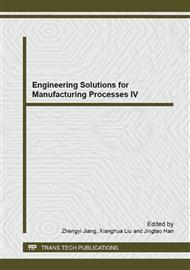[1]
S. Cai, P. Shen, On the methods solving nonlinear equations. Journal of Hunan University, 27(3), (2000), 86-91.
Google Scholar
[2]
M. A. Crisfield, Nonlinear Finite Element Analysis of Solids and Structures, vol. 2: Advanced Topics, John Wiley & Sons Ltd., Chichester, England (1997).
Google Scholar
[3]
J. L. Meek, H. S. Tan, Geometrically nonlinear analysis of space frames by an incremental itera-tive technique. Compute. Meths. Appl. Mech. Engrg, 47, (1984), 261-282.
DOI: 10.1016/0045-7825(84)90079-3
Google Scholar
[4]
E. Riks, An incremental approach to the solution of snapping and buckling problems. International Journal of Solids and Structures, 15, (1979), 529-551.
DOI: 10.1016/0020-7683(79)90081-7
Google Scholar
[5]
L. J. Leu, Y. B. Yang, Effects of rigid body and stretching on nonlinear analysis of trusses. Journal of Structural Engineering, ASCE, 116, (1990), 2582-2598.
DOI: 10.1061/(asce)0733-9445(1990)116:10(2582)
Google Scholar
[6]
E. W. Wright and E. H. Gaylord, Analysis of unbraced multistory steel rigid frames. International Journal of Structural Division ASCE, 94(1968)1143-1163.
DOI: 10.1061/jsdeag.0001948
Google Scholar
[7]
P. G. Bergan, G. Horrigmoe, B. Krakeland and T. H. Soreide, Solution techniques for nonlinear finite element problems. International Journal for Numerical Methods in Engineering, 12(1978)1677-1696.
DOI: 10.1002/nme.1620121106
Google Scholar
[8]
E. Riks, The application of Newton's method to the problem of elastic stability. Journal of Applied Mechanics, 39(1972)1060-1065.
DOI: 10.1115/1.3422829
Google Scholar
[9]
E. Riks, An incremental approach to the solution of snapping and buckling problems. International Journal of Solids and Structures, 15(1979)529-551.
DOI: 10.1016/0020-7683(79)90081-7
Google Scholar
[10]
G. A. Wempner, Discrete approximation related to nonlinear theories of solids. International Journal of Solids and Structures, 7(1971)1581-1599.
DOI: 10.1016/0020-7683(71)90038-2
Google Scholar
[11]
J. L. Baltoz and G. Dhatt, Incremental displacement algorithms for nonlinear problems. International Journal for Numerical Methods in Engineering, 14(1979)1262-1266.
DOI: 10.1002/nme.1620140811
Google Scholar
[12]
E. Ramm, Strategies for Tracing the Nonlinear Response near Limit Points. In: Nonlinear Finite Element Analysis in Structural Mechanics. Springer, New York, (1981)68-89.
DOI: 10.1007/978-3-642-81589-8_5
Google Scholar
[13]
I. Fried, Orthogonal trajectory accession to the nonlinear equilibrium curve. Computer Methods in Applied Mechanics and Engineering, 47(1984)283-298.
DOI: 10.1016/0045-7825(84)90080-x
Google Scholar
[14]
B. W. R. Forde and S. F. Stiemer, Improved arc-length orthogonality methods for nonlinear finite element analysis. Computer and Structures, 27(5)(1987)625-630.
DOI: 10.1016/0045-7949(87)90078-2
Google Scholar
[15]
S. N. Al-Rasby, Solution techniques in nonlinear structural analysis. Computer and Structures, 40(4)(1991) 985-993.
DOI: 10.1016/0045-7949(91)90329-k
Google Scholar
[16]
M. Fafard and B. Massicotte, Geometrical interpretation of the arc-length method. Computer and Structures, 46(4)(1993)603-615.
DOI: 10.1016/0045-7949(93)90389-u
Google Scholar
[17]
P. X. Bellini and A. Chulya, An improved automatic incremental algorithm for the efficient solution of nonlinear finite element equations. Computer and Structures, 26(1-2)(1987)99-110.
DOI: 10.1016/0045-7949(87)90240-9
Google Scholar
[18]
E. Carrera, A study on arc-length type methods and their operation failures illustrated by a simple model. Computer and Structures, 50(2)(1994)217-229.
DOI: 10.1016/0045-7949(94)90297-6
Google Scholar
[19]
M. A. Crisfield, A fast incremental/iterative solution procedure that handles snap-through. Computer and Structures, 13(1981)55-62.
DOI: 10.1016/0045-7949(81)90108-5
Google Scholar
[20]
M. A. Crisfield, An arc-length method including line searches and accelerations. International Journal for Numerical Methods in Engineering, 19(1983)1269-1289.
DOI: 10.1002/nme.1620190902
Google Scholar
[21]
Z. L. Fan, A study of variable step-length incremental/iterative methods for nonlinear finite element equations. Computer and Structures, 52(6)(1994)1269-1275.
DOI: 10.1016/0045-7949(94)90190-2
Google Scholar
[22]
Y. T. Feng, D. Peric, and D. R. J. Owen, A new criterion for determination of initial loading parameter in arc-length methods. Computer and Structures, 58(3)(1996)479-485.
DOI: 10.1016/0045-7949(95)00168-g
Google Scholar
[23]
S. Foster, An application of the arc-length method involving concrete cracking. International Journal for Numerical Methods in Engineering, 33(1992)269-285.
DOI: 10.1002/nme.1620330204
Google Scholar
[24]
H. B. Hellweg and M. A. Crisfield, A new arc-length method for handling sharp snap-backs. Computer and Structures, 66(5)(1998)705-709.
DOI: 10.1016/s0045-7949(97)00077-1
Google Scholar
[25]
S. R. Kuo and Y. B. Yang, Tracing post buckling paths of structures containing multi-loops. International Journal for Numerical Methods in Engineering, 38(1995)4053- 4075.
DOI: 10.1002/nme.1620382309
Google Scholar
[26]
J. H. Kweon and C. S. Hong, An improved arc-length method for post-buckling analysis of composite cylindrical panels. Computer and Structures, 53(3)(1994)541-549.
DOI: 10.1016/0045-7949(94)90099-x
Google Scholar
[27]
W. F. Lam and C. T. Morley, Arc-length method for passing limit points in structural calculation. Journal of Structural Engineering, 118(1)(1992)169-185.
DOI: 10.1061/(asce)0733-9445(1992)118:1(169)
Google Scholar
[28]
I. M. May and Y. Duan, A local arc-length procedure for strain softening. Computer and Structures, 64(1-4)(1997)297-303.
DOI: 10.1016/s0045-7949(96)00172-1
Google Scholar
[29]
J. G. Teng and Y. F. Luo, A user-controlled arc-length method for convergence to predefined de-formation states. Communications in Numerical Methods in Engineering, 14(1998)51-58.
DOI: 10.1002/(sici)1099-0887(199801)14:1<51::aid-cnm130>3.0.co;2-l
Google Scholar
[30]
Z. L. Zhou and D. W. Murray, An incremental solution technique for unstable equilibrium paths of shell structures. Computer and Structures, 55(5)(1994)749-759.
DOI: 10.1016/0045-7949(94)00474-h
Google Scholar


